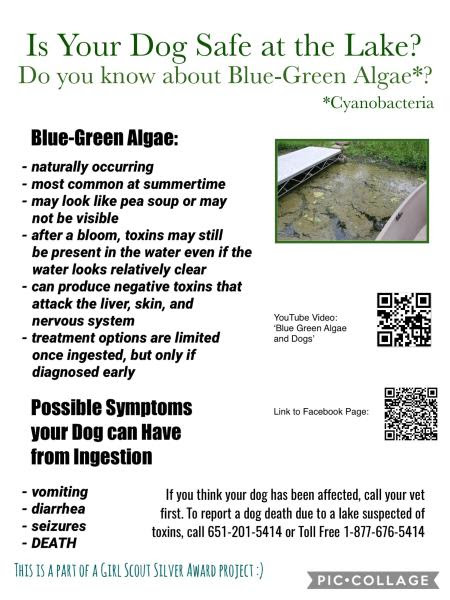This month, our feature article was inspired by two eighth grade girls, Scarlett Morton and Elsa Yager, Girl Scout Troop #54296, working on their Girl Scout Silver Award Project. The Silver Award Project is a project designed to help the community. They chose to educate our community on blue-green algae, because sadly, Elsa’s family dog, Barney, passed away suddenly last year due to this toxin. Their hope is to spread the awareness of the dangers of this toxin to help save other pets’ lives.
View their project here!

Cyanobacteria, also known as blue-green algae, are bacteria that grow in slow moving or stagnant water such as ponds, lakes, or streams, especially in areas where water is rich in nutrients such as fertilizer. These bacteria are often called algae because of their appearance on the water, but they are not truly algae. These bacteria grow rapidly during the summer months, leading to accumulations along the shores. You cannot always visualize these algal blooms. Sometimes there is a ‘pea soup’ appearance to the water, but affected water can range from clear to blue to even red in color.
We cannot determine if the cyanobacteria are present just by its appearance, so all blooms should be considered potentially toxic. Blue-green algae produce two types of toxins:
a) Hepatotoxins (microcystins): These toxins can damage the liver. Symptoms may take 12-24 hours to develop and may include lack of appetite, vomiting, diarrhea, dark stool, jaundice, disorientation, seizures, and death.
b) Neurotoxins (anatoxins): These toxins cause toxicity to the nervous system. Symptoms are seen within minutes to hours and may include disorientation, weakness, inability to walk, muscle tremors, seizures, difficulty breathing, blue gums and skin, and sudden death.
If you think your pet has been exposed, seek veterinary care immediately. Unfortunately, there is no specific antidote and prognosis for those patients showing clinical signs is poor. Depending on the type of toxin and the level of exposure, some toxicities are so severe that dogs don’t even have time to reach the veterinarian for supportive care.
Prevention is the key. Avoid letting your pet swim in water with obvious algae growth or discoloration; stagnant water sources are more likely to be affected. Seek veterinary attention immediately if you think your pet has had exposure.
For additional resources, please visit the Pet Poison Helpline at http://www.petpoisonhelpline.com/poison/blue-green-algae/ and Animal Emergency & Referral Center at http://aercmn.com/blog/posts/dangers-of-blue-green-algae/.
Anxiety: Thunderstorms and Fireworks
Does your dog shake when it starts to thunder? Does he hide when it begins to rain? Does she destroy the furniture when she’s left alone during a thunderstorm? If you’ve answered yes, your dog may have a thunderstorm phobia.
Do you cringe as we get closer to the 4th of July? Does your dog or cat spend the holiday underneath the bed or in the closet? Fireworks can cause significant fear and anxiety in our pets as well.
If your pet has thunderstorm phobias or anxiety associated with fireworks, please talk to us – – we can help! Thundershirts, herbal calming supplements (Composure or Solliquin), calming collars (Adaptil collar or NurtureCALM), or anti-anxiety medications such as trazodone, alprazolam, or Sileo are great options for your pet.
Sileo is a gel containing dexmedetomidine that is absorbed through the gums. It is an FDA-approved treatment for noise aversion. For most dogs, it calms without causing excessive sedation, though as with any medication, it is important to monitor closely for adverse effects with use. It should be administered 30-60 minutes prior to the event and can be redosed every 2 hours up to five times.
If we prescribe Sileo for your dog, it is very important that you understand how to dose it appropriately. Please discuss proper use of the dosing syringe and locking mechanism with the staff to avoid accidental overdose. Click here to learn more about Sileo and to watch a video on proper administration. Note: Sileo is not for everyone and should not be used in dogs with cardiovascular disease, kidney disease, liver disease or respiratory disease. Some dogs experience significant sedation with this medication.
Please contact us at (651) 645-2808 if your pet suffers from anxiety associated with fireworks or thunderstorms.
Summer: Hot Temperatures and Your Dog
Your pet can rapidly overheat when left outdoors in hot humid conditions without adequate shade, when exercised in hot humid weather, or when left in a car in the summer. Keep in mind that, even on a relatively cool day (70° F), the temperatures in the car will near 100° F. Other predisposing factors for overheating include obesity or diseases affecting a pet’s airway.
Preventing heat stroke is key, but if your dog has been in one of these situations, it is essential that you recognize the signs and respond promptly. Initially the dog may appear distressed. He or she may be restless or panting more than usual. As the hyperthermia progresses, your dog may drool large amounts of saliva from the nose or mouth and may become weak or unsteady. You may notice the gums turning lavender or bright red in color.
If you notice thse signs, remove your pet from the environment where the hyperthermia occurred. Move your pet to a shaded and cool environment, and if possible, obtain a rectal temperature. Begin to cool the body by placing cool, wet towels over the back of the neck, in the armpits, and in the groin region. You may also wet the ear flaps and paws with cool water. Directing a fan on these wetted areas will help to speed evaporative cooling.
It is very important to not overcool the pet. Most pets with hyperthermia have body temperatures greater than 105°F, and a reasonable goal of cooling is to reduce your pet’s body temperature to 102.5-103°F while transporting him or her to the closest veterinary facility. Offer fresh cool water but do not force water into your pet’s mouth.
Most importantly, transport your pet to the closest veterinary facility as quickly as possible. If your pet is critical, it is best to go directly to a 24-hour hospital such as the Animal Emergency & Referral Center or to the University of Minnesota as extended intensive care will likely be necessary.
Animal Emergency & Referral Center: St Paul 651-293-1800 or Oakdale 651-501-3766.
U of M: 612-626-8387
The most important thing is to prevent situations in which your pet could overheat. Never leave a pet in the car, even on a moderately warm day. Walk your dog in the early morning or evening hours when it is cooler and always have fresh water available when your pet is outside.
News Briefs
Roseville Rose Parade
We’ll be in the Rosefest Rose Parade starting at 6:15 pm on Monday, June 25th. St. Francis Animal Hospital is currently #17 on the list of parade participants. We’ll be handing out candy, dog treats, information about our practice, and coupons to use at St. Francis Animal Hospital. If you missed the parade, stay tuned to Facebook for photos.
Roseville Review Readers’ Choice Awards.
Do you love St Francis? Please take a moment today to vote for St. Francis Animal Hospital for Best Place for Pet Care in the Roseville Review Reader’s Choice Awards. You must vote in 20 categories to enter. Voting deadline is Friday, July 13th. We would be honored to have your vote! Click here to vote!
Rabies Alert: Bat in Como Park
A rabies positive bat was found near the pavilion by Como Lake in St. Paul on Wednesday, May 30.
We recommend that all dogs, cats, and ferrets be currently vaccinated against the rabies virus. In the event that an animal is exposed or potentially exposed, pets should be rabies vaccinated within 96 hours of exposure.

